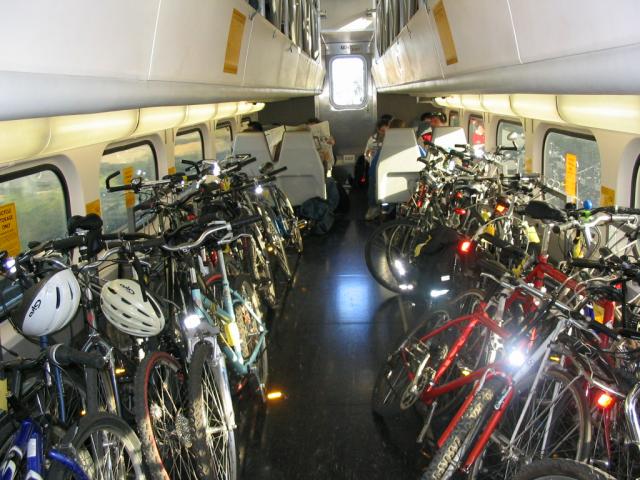By Tasha Bartholomew, @tashbart While this may sound cliché, Caltrain has become a victim of its own success when it comes to the popular onboard bicycle program the agency provides for some of its passengers. We're learning as we grow but we're extremely proud of the progress that we've made to date as a national leader in bringing bikes onboard to enhance the first and last mile
commute. Caltrain first welcomed bikes onboard trains in 1992 with a pilot program that only allowed four bikes on a few trains. Over the years, the rail agency has made incremental improvements in capacity. Today, Caltrain’s bike program is a national model, with the rail agency boasting the most bike-friendly system in the country. Currently all trains are equipped with two bike cars, which hold 80 bikes on the older gallery-car trains and 48 bikes per train on the newer
Bombardier style cars. Bikes are allowed on a first-come, first-served basis, with none of the peak-hour restrictions found on most transit systems. Ridership on Caltrain is a historic high, with nearly 60,000 riders boarding the train on an average weekday. Bike riders make up approximately 6,200 of those customers. Earlier this year, Caltrain purchased 16 used rail cars in response to the growth in demand on the railroad and significant overcrowding on many of its peak-hour trains. Four of those trains were put into service this earlier week, following some maintenance and minor repair and conversion work. The other 12 cars require more extensive repair work and will be rolled into service as they are ready. Additional work includes converting a number of the new cars to accommodate onboard bicycle storage. When the conversion project is complete, Caltrain will add a third bike car to Bombardier train sets bringing the total number of bike spaces available on those sets to 72. The agency hopes to begin bringing those additional bike cars online within the next year. History of Bikes Onboard: 1992 Demonstration project; four bikes in the cab car of off‐peak trains. 1995 All trains; 12 bikes per train. 1996 All trains; increases to 24 bikes per train. 2001 Gallery car capacity increases to 32 bikes per train. 2004 – 2008 Bikes increase from 76 to 98 trains on weekdays; total bike slots increased from 3,000 to 4,000. 2006 Every train has a guaranteed 16‐ or 32 ‐bike capacity: Bombardier trains carry 16 bikes; gallery trains carry 32. There are no peak hour or direction restrictions, other than capacity. Additional fees or permits are not required for bringing a bike onboard. 2008 Bicycle Access and Parking Plan; focuses on system wide improvements to bicycle access and parking, as well as specific access and parking improvements at the 10 Caltrain stations with the highest bicycle use. 2009 Caltrain increases on-board bike capacity on the gallery cars from 32 bike slots to 40 and on the Bombardier cars from 16 to 24. This is a 28 percent increase in system wide bike capacity. 2010 Bicycle Advisory Committee is formed to serve as the primary venue for the interests and perspectives of bicyclists. The group is made up of representatives from each of the three counties served by Caltrain: San Francisco, San Mateo and Santa Clara. One member from each county is a public agency staff member responsible for bike planning and/or policy development; one is a representative of a bicycle advocacy organization in the county and one is a Caltrain bike passenger from the general public. 2011 Two bike cars on every train. The project costs $300,000. Older gallery-car trains are equipped with two bike cars with a capacity for 40 bikes in each car for a total capacity of 80 bikes on each train. The newer Bombardier cars are able to hold 24 bikes per car for a total capacity of 48 bikes per train. To provide consistent service and facilitate boarding, bike cars are in the same position on every train – one at the northern-most end of the train and one near the middle of the train, two cars north of the locomotive. Bike cars are identified with a yellow bike decal on the outside. 2011 Caltrain amends its youth bicycle policy, allowing children six years and older who are accompanied by an adult to bring a bike on the train. All cyclists must be able to carry their own bike on and off the train. The minimum age was lowered from 12 to encourage families to consider taking Caltrain on outings. 2015 Caltrain still maintains two bike cars on every train; there are 92 weekday trains. Within the year, Caltrain will be adding a third bike car to Bombardier cars adding bring the total number of bike spaces from 48 to 72.
